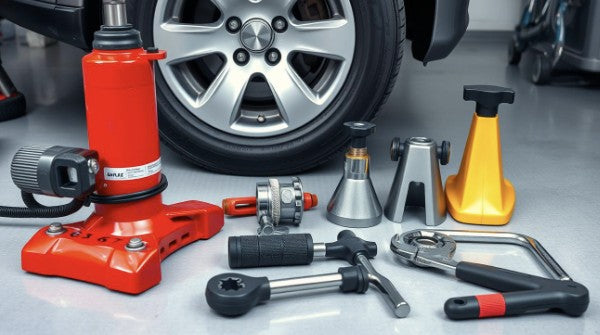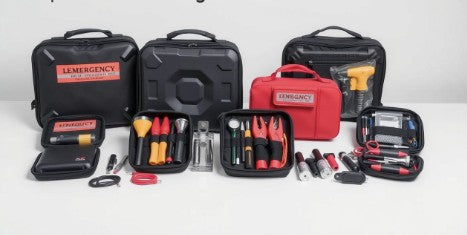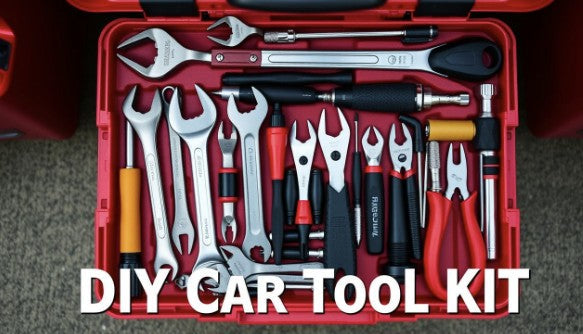Changing a car tires might seem like a simple task, but having the right tools can make the difference between a smooth 15-minute job and hours of frustrating struggle. Whether you're preparing for emergencies or looking to save money on regular tire rotations, investing in quality tire changing tools ensures both your safety and efficiency. This guide covers the essential tools every car owner should have for changing tires properly.
Why Proper Tires Changing Tools Matter
Using the right tools for changing tires isn't just about convenience—it's about safety. Improper equipment can lead to accidents, vehicle damage, or personal injury. Quality tools also help preserve your wheel components and ensure proper installation, preventing issues like loose wheels or uneven wear.
Benefits of Quality Tire Changing Tools
- Significantly reduces the time needed to change tires
- Ensures proper torque application to prevent wheel damage
- Minimizes physical strain and potential injuries
- Provides self-sufficiency during roadside emergencies
- Saves money on professional tire change services
Risks of Inadequate Tools
- Increased risk of vehicle damage during tire changes
- Potential for personal injury from slipping tools
- Improper wheel installation leading to safety hazards
- Frustration and wasted time with inefficient equipment
- Possible damage to wheel rims and lug nuts
8 Essential Tools for Changing Car Tires
Here's our comprehensive list of must-have tools that make tire changing safer, faster, and easier. Each tool serves a specific purpose in the tire changing process.
1. Hydraulic Floor Jack
A quality hydraulic floor jack is the foundation of safe tire changing. Unlike the emergency scissor jacks that come with most vehicles, a hydraulic floor jack provides stable lifting power with minimal effort.
Never rely solely on a jack to support your vehicle while changing tires. Always use jack stands for additional safety.
Key Features to Look For:
- Lifting capacity of at least 2 tons for most passenger vehicles
- Low-profile design to fit under vehicles with minimal ground clearance
- Quick-lift mechanism to reduce pumping effort
- Built-in safety valve to prevent overloading
Where to Buy Hydraulic Floor Jacks
Quality floor jacks range from $100-$200 depending on capacity and features. Look for trusted brands with good warranties.
2. Jack Stands
Jack stands are non-negotiable safety equipment that provide stable support for your vehicle once it's lifted. They prevent catastrophic accidents if your hydraulic jack fails during the tire change process.
Key Features to Look For:
- Weight capacity that matches or exceeds your floor jack
- Adjustable height to accommodate different vehicles
- Wide base for stability on various surfaces
- Ratcheting or pin-locking mechanisms for secure height settings
Always place jack stands on solid, level ground and position them at manufacturer-recommended lifting points. Never substitute jack stands with makeshift supports like bricks or wood blocks.
Where to Buy Jack Stands
Quality jack stands typically cost between $40-$80 for a pair. Always buy from reputable sources to ensure safety standards.
3. Lug Wrench
A proper lug wrench provides the leverage needed to loosen and tighten wheel nuts. While most cars come with a basic wrench, upgrading to a four-way lug wrench or telescoping wrench offers significant advantages.
Key Features to Look For:
- Four-way design for maximum leverage and multiple socket sizes
- Telescoping handle for adjustable leverage
- Sockets that properly fit your vehicle's lug nuts
- Durable construction with anti-slip grip
Where to Buy Lug Wrenches
Quality lug wrenches range from $15-$40 depending on features. Four-way wrenches offer the best value for most users.
4. Torque Wrench
A torque wrench is essential for properly tightening wheel nuts to manufacturer specifications. This precision tool prevents both over-tightening (which can damage threads and wheels) and under-tightening (which can lead to wheels coming loose).
Key Features to Look For:
- Appropriate torque range for your vehicle (typically 50-150 ft-lbs for passenger cars)
- Click-type mechanism for precise torque application
- Clear scale markings in both ft-lbs and Nm
- Calibration certificate or calibration capability
Always check your vehicle's manual for the exact torque specifications for your wheel nuts. Typical passenger cars require between 80-100 ft-lbs, but this varies by manufacturer.
Where to Buy Torque Wrenches
Quality torque wrenches range from $40-$150 depending on precision and features. Mid-range options around $60-80 are sufficient for most DIY users.
5. Wheel Chocks
Wheel chocks prevent your vehicle from rolling while jacked up, providing an essential layer of safety during tire changes. They're particularly important when changing tires on slight inclines.
Key Features to Look For:
- Non-slip rubber or high-friction material
- Weather-resistant construction
- Appropriate size for your vehicle's tires
- High-visibility coloring
Where to Buy Wheel Chocks
Quality wheel chocks typically cost between $15-$30 for a pair. Rubber or heavy-duty plastic options offer the best combination of grip and durability.
6. Tire Pressure Gauge
A reliable tire pressure gauge ensures your newly installed tires are inflated to the correct pressure, which is crucial for safety, handling, and fuel economy.
Key Features to Look For:
- Digital display for precise readings
- Backlit screen for visibility in low light
- Range appropriate for passenger vehicles (0-100 PSI)
- Multiple pressure units (PSI, BAR, kPa)
Where to Buy Tire Pressure Gauges
Quality digital tire pressure gauges range from $10-$30. Analog stick gauges are cheaper but less accurate.
7. Portable Air Compressor
A portable air compressor allows you to inflate tires to the correct pressure anywhere, making it invaluable for both routine tires changes and roadside emergencies.
Key Features to Look For:
- Maximum pressure rating of at least 100 PSI
- Digital pressure gauge with auto-shutoff
- 12V power connection for car use
- Adequate cord length to reach all tires
- Compact storage case
Where to Buy Portable Air Compressors
Quality portable air compressors range from $30-$100 depending on features and power. Models with digital displays and auto-shutoff provide the best user experience.
8. Wheel Cleaning Brush
A wheel cleaning brush or wire brush helps remove corrosion and debris from wheel hubs and mounting surfaces, ensuring proper wheel installation and preventing future removal difficulties.
Key Features to Look For:
- Stiff wire bristles for effective corrosion removal
- Comfortable handle with good grip
- Appropriate size for reaching wheel hub surfaces
- Durable construction that won't shed bristles
Where to Buy Wheel Cleaning Brushes
Quality wheel cleaning brushes typically cost between $5-$15. Look for options with stainless steel bristles for durability.
Tire Changing Tools Comparison
This comparison table helps you quickly identify which tools to prioritize based on your specific needs and budget.
|
Tool |
Essential Level |
Price Range |
Durability |
Skill Required |
|
Hydraulic Floor Jack |
Must-Have |
$100-$200 |
10+ years |
Low |
|
Jack Stands |
Must-Have |
$40-$80 |
10+ years |
Low |
|
Lug Wrench |
Must-Have |
$15-$40 |
Lifetime |
Very Low |
|
Torque Wrench |
Must-Have |
$40-$150 |
5-10 years |
Medium |
|
Wheel Chocks |
Must-Have |
$15-$30 |
5+ years |
Very Low |
|
Tire Pressure Gauge |
Must-Have |
$10-$30 |
3-5 years |
Very Low |
|
Portable Air Compressor |
Highly Recommended |
$30-$100 |
3-5 years |
Low |
|
Wheel Cleaning Brush |
Recommended |
$5-$15 |
1-2 years |
Very Low |
Safety Tips for Changing Tires
Even with the right tools, following proper safety procedures is crucial when changing tires. These tips help ensure your safety throughout the process.
Before Jacking the Vehicle
- Park on a flat, solid surface away from traffic
- Apply the parking brake and put the vehicle in "Park" (automatic) or first gear (manual)
- Place wheel chocks on the wheels diagonal to the one being changed
- Loosen (but don't remove) the lug nuts before jacking up the vehicle
- Identify the proper jacking points using your vehicle's manual
During and After the Tire Change
- Never place any part of your body under the vehicle while it's supported only by a jack
- Always use jack stands once the vehicle is raised
- Tighten lug nuts in a star pattern to ensure even pressure
- Use a torque wrench to achieve proper tightening specifications
- Recheck all lug nuts after driving 50-100 miles
Never attempt to change a tire on soft ground, an incline, or near traffic without proper safety precautions. If you're in an unsafe location, call for roadside assistance instead.
Pro Tips for Quick and Efficient Tires Changes
These expert tips can help you change tyres more quickly without compromising safety.
Preparation Tips
- Organize your tools in advance and keep them in a dedicated container
- Use a mechanics mat or old carpet to protect your knees and catch dropped lug nuts
- Keep a headlamp or portable work light for visibility in low-light conditions
Technique Tips
- Position the replacement tyre flat on its side for easy mounting
- Use your body weight rather than arm strength when loosening stubborn lug nuts
- Apply a small amount of anti-seize compound to wheel studs to prevent future corrosion
Efficiency Tips
- Partially tighten all lug nuts before fully tightening any of them
- Keep valve stem caps in your pocket during the change to avoid losing them
- Mark seasonal tyres with chalk to remember their position for even wear
The most efficient tyre changes come from practice and preparation. Having your tools organized and knowing the exact steps saves more time than rushing through the process.
- Professional Mechanic with 20+ years experience
Buying Guide: How to Choose Quality Tyre Changing Tools
When investing in tyre changing tools, consider these factors to ensure you get equipment that offers the best balance of quality, durability, and value.
Key Considerations When Buying Tyre Changing Tools
What weight capacity do you need?
For jacks and jack stands, always choose a capacity that exceeds your vehicle's weight. For most passenger cars, a 2-ton (4,000 lb) capacity is sufficient, while SUVs and trucks may require 3-ton (6,000 lb) or higher capacity tools.
How important is brand reputation?
For safety-critical items like jacks and jack stands, stick with established brands that have strong safety records. Budget options may be acceptable for less critical tools like tyre pressure gauges or wheel brushes.
Should you buy individual tools or kits?
Comprehensive tyre changing kits can offer good value but often include lower-quality components. For critical safety items, buying individual high-quality tools is usually better than settling for kit components.
How much should you spend?
A complete set of quality tyre changing tools represents an investment of approximately $300-$500. While this may seem significant, it pays for itself after just a few seasonal tyre changes compared to professional service costs.
Recommended Brands by Tool Category
|
Tool Type |
Budget Option |
Mid-Range Option |
Premium Option |
|
Hydraulic Jack |
Pro-Lift ($70-90) |
Torin Big Red ($100-130) |
Arcan ($150-200) |
|
Jack Stands |
Torin ($30-40) |
Omega ($50-70) |
ESCO ($80-100) |
|
Torque Wrench |
Tekton ($40-50) |
CDI Torque ($80-120) |
Snap-on ($150+) |
|
Lug Wrench |
Cartman ($15-20) |
Gorilla ($25-35) |
Powerbuilt ($40-50) |
Complete Your Tyre Changing Tool Collection
Ready to invest in quality tyre changing tools? Start with the essential safety items first: a good jack, jack stands, and torque wrench.
Maintaining Your Tyre Changing Tools
Proper maintenance of your tyre changing tools ensures they remain safe and functional for years to come. Follow these care tips for each tool type.
Hydraulic Jack Maintenance
- Check hydraulic fluid levels every 6 months
- Lubricate moving parts with machine oil
- Store in upright position to prevent air in hydraulic system
- Inspect for leaks or damage before each use
Jack Stands & Wrenches
- Clean and remove dirt after each use
- Apply light oil to prevent rust on metal surfaces
- Check for bent components or damaged teeth
- Store in dry location away from extreme temperatures
Torque Wrench Care
- Always return to lowest setting after use
- Store in protective case to prevent damage
- Recalibrate annually if used frequently
- Never use as a breaker bar for loosening nuts
Create a maintenance schedule and perform quick inspections before each use. This preventive approach ensures your tools remain safe and extends their useful life significantly.
Conclusion: Investing in the Right Tyre Changing Tools
Having the right tools for changing tyres is an investment in both safety and convenience. While the initial cost may seem significant, quality tyre changing tools pay for themselves over time through savings on professional services and the ability to handle emergencies confidently.
Remember that safety should always be your primary concern when changing tyres. Never compromise on the quality of critical safety equipment like jacks and jack stands. With proper tools, techniques, and maintenance, you can change tyres safely and efficiently for years to come.
Ready to Build Your Tyre Changing Toolkit?
Start with the essential safety items first and gradually build your complete collection. Quality tools are an investment that pays dividends in safety and convenience.




Leave a comment
This site is protected by hCaptcha and the hCaptcha Privacy Policy and Terms of Service apply.